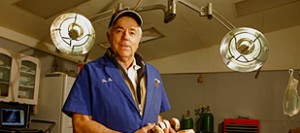Dr. Rick Beck
Doctor of Veterinary Medicine
Dr. Beck was born and raised on a cattle ranch in Deer Lodge, Montana. He began his veterinary journey with pre-vet studies at Montana State University in Bozeman, then earned his Doctor of Veterinary Medicine from Colorado State University in Fort Collins, Colorado.
After graduation, Dr. Beck moved to California, drawn by the green grass, blue skies, and a climate that allowed for year-round equine reproductive work. In 1987, he settled in Hemet, California, and by 1990 he had purchased 10 acres in Diamond Valley, where he founded InFoal,Inc.
After 35 years of practicing in California, Dr. Beck relocated to Millsap, Texas, in July of 2021, continuing his passion for equine reproduction and advanced breeding technologies.


The Goal
The technical advances in equine reproduction have made it possible to preserve and promote the superior genetics of outstanding individual horses that only a few years ago were lost to the population. First artificial insemination (AI), then embryo transfer (ET) and now intracytoplasmic sperm injection (ICSI) have added to the list of options we can use to salvage foals from both compromised mares and stallions whose semen is of poor quality or in short supply. Thru ICSI, our goal is to produce foals from mares that have a uterus that can no longer produce an embryo or to salvage eggs from a mare that just died. Secondly, thru ICSI, our goal is to maximize the use the last few straws of semen from a deceased stallion by using only one sperm cell to produce a foal.
Test Tube Horses
The technology of Intracytoplasmic Sperm Injection (Iused in human fertility clinics has now been applied to horses. The miracle of producing a foal from an infertile mare or salvaging many foals from one straw of semen from a deceased stallion are now possible. What originally began as academic research has now reached the point of commercial application in a few private veterinary hospitals specializing in equine reproduction.
Colorado Sate University and Texas A&M are the primary centers of research in equine reproduction. Due to the investment in laboratory facilities, equipment and supplies, which can easily reach several hundred thousand dollars, in addition to the learning curve of several years, there are only a couple of private veterinary hospitals offering these services. Dr. Rob Foss at Equine Medical Center in Columbia, Missouri and Dr. Rick Beck at IN Foal, Inc. in Hemet, California are the two hospitals that have produced several live foals by this procedure.
After collection an oocyte (horse egg) from a follicle on the mares ovary, a microscope with micromanipulators is used to mechanically inject one sperm cell into the egg. After 8 days in the incubator, the embryo is transferred into the uterus of a recipient mare (serrugate mother) that will give birth 11 months later. The application of this cutting edge technology has produced foals from outstanding genetic individuals that otherwise would have been lost to the gene pool.


